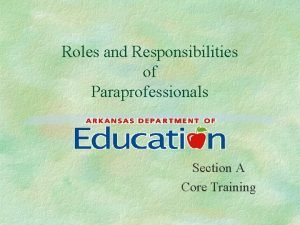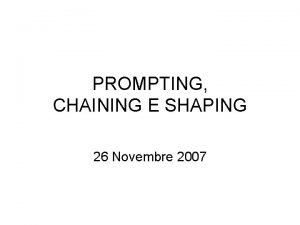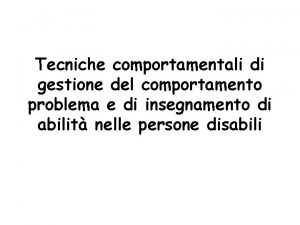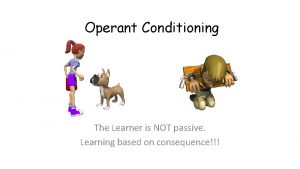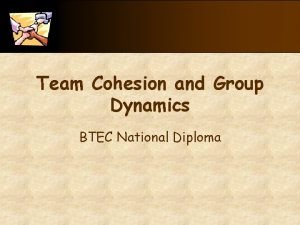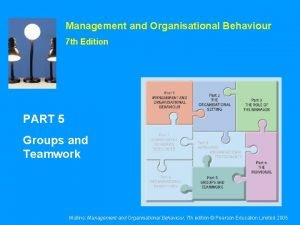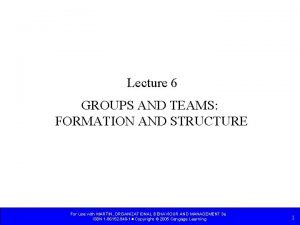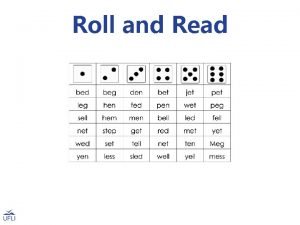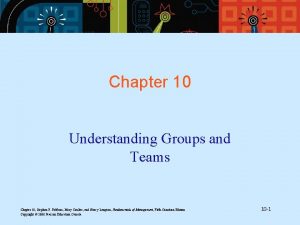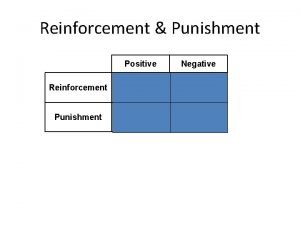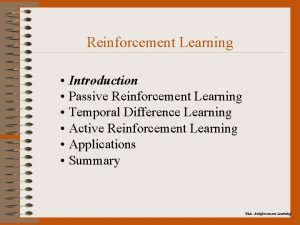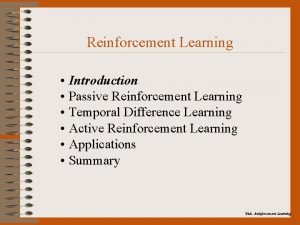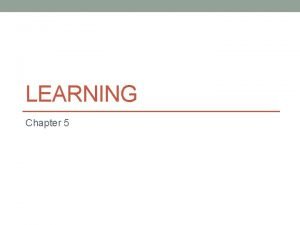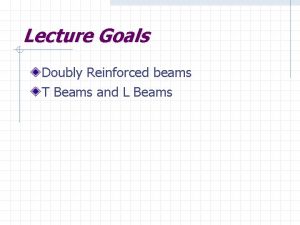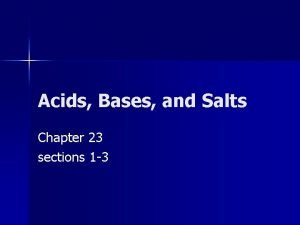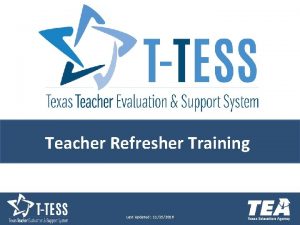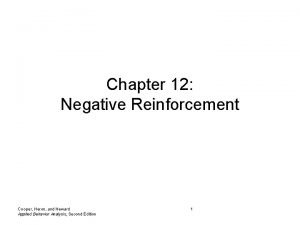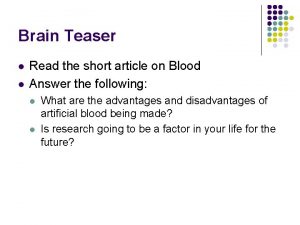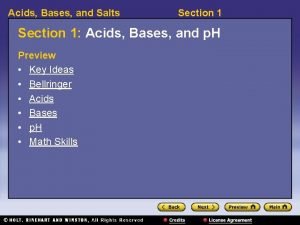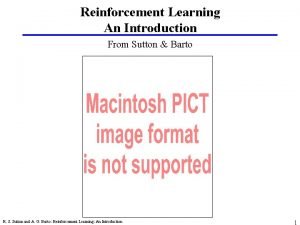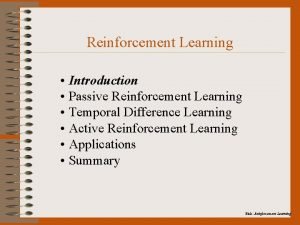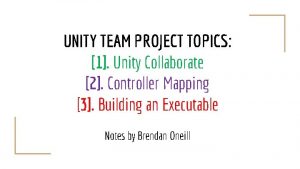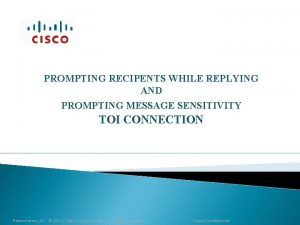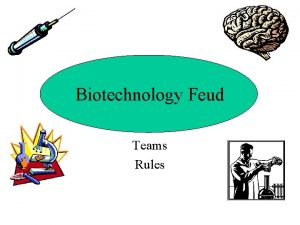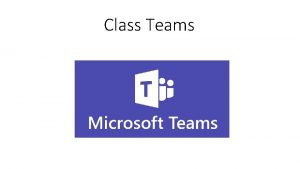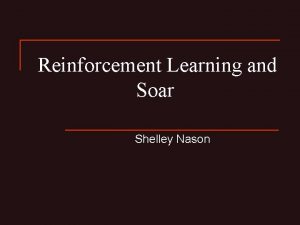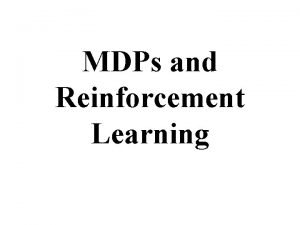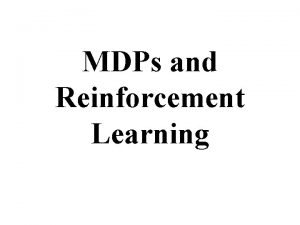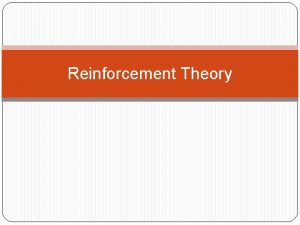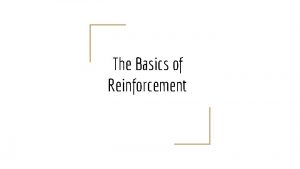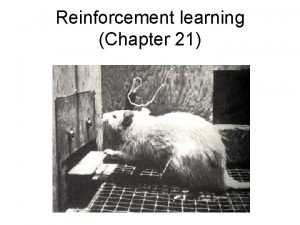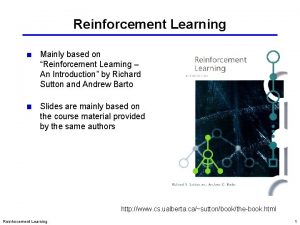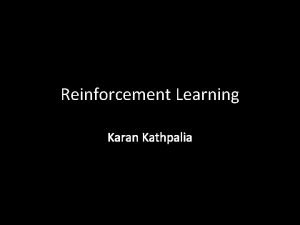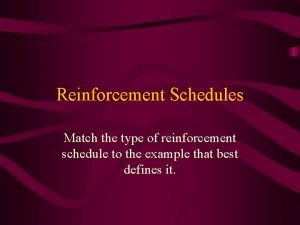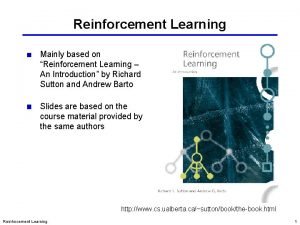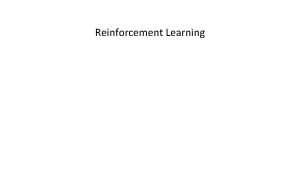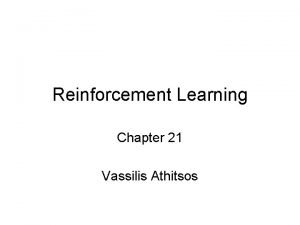Paraprofessional Training Teams Prompting and Reinforcement What makes













































- Slides: 45

Paraprofessional Training: Teams, Prompting and Reinforcement

What makes a professional, healthy and effective team between a teacher and paraprofessional? All members know their roles and how to perform those roles. All members use open communication that is: Professional Student Based centered on best practices

What makes a professional, healthy and effective team between a teacher and paraprofessional? Let’s hear from the experts. Remember that when healthy relationships are established that a mistake is simply a mistake. Mandt

Paraprofessional Roles Escort, assist and supervise students across environments/activities Assist teachers in implementing behavior plans including observation, data collection and reinforcer delivery Assist teachers in testing, scoring and record maintenance

Paraprofessional Roles Practice previously learned skills Communicate problems to the supervising teacher Guide independent study and remedial work assigned by the teacher Assist the teacher in maintaining and organizing work, study areas, equipment and materials

Paraprofessional Roles Perform health related procedures Participate Inform in parent conferences and assist substitute teachers Attend specialized training as required to assist in implementation of the IEP Perform other duties as assigned by the teacher or administrator

Best Practices for Paraprofessionals Do demonstrate R-E-S-P-E-C-T for students by encouraging responsibility; having high expectations; speaking with them instead of about them; using positive statements to tell them specifically what you want them to do; enjoying their uniqueness as people first; offering choices when practical; and treating them as you wish to be treated. Demonstrate this respect with your words, actions, tone and body language. Do know your job description. Do learn about the student’s abilities. Require their best. Teach to their strengths, learning style and interests. Do learn about the student’s disability. Be patient with deficits, while you teach to improve these.

Best Practices for Paraprofessionals Do model appropriate social skills at all times. Assume your students understand all conversations, so keep them relevant to the classroom. Do follow your teacher’s directives. She is the decision maker in the classroom and the person directly responsible for the students’ progress. Assist her by actively seeking opportunities to enhance the learning atmosphere within the classroom. Do support all students in the classroom when available, even if you are assigned to a particular student for the majority of the time. Remain flexible and supportive to the class as a whole. Do foster independence by using least intrusive prompts. Choose visual strategies over verbal prompting. Allow time for the student to process the situation and respond independently.

Best Practices for Paraprofessionals Do remain calm, firm and respectful during a student crisis. Do catch your students being good. Recognize, praise and attend to these accomplishments, however easy they seem to you. Do actively participate in all trainings and apply what you learn. If necessary ask for clarification. Don’t replace the role of the teacher by reporting detailed information to parents. Don’t interfere with natural learning opportunities by positioning yourself between the student and the teacher or interrupting positive interactions with peers.

Best Practices for Paraprofessionals Don’t engage in personal activities such as emailing, texting or phone calls during your shift. Don’t compare your duties to that of another ICA. The purpose of your position is to support an individual education plan. Don’t develop a dependence upon the student that you support. The IEP states a service, not a person. Generalization is promoted when the student learns to respond to a variety of individuals. Don’t define a student by their behavior. Remember that we are all a work in progress.

Prompting

Prompting procedures Include any assistance given to learners that assist them in using a specific skill. Information. Can be used to teach a variety of skills: including seeking information, pointing to objects, identifying numbers/objects, and remaining "on task. “ Can be used effectively, across cognitive levels, communicative abilities, and age ranges Help learners acquire skills by systematically providing and removing prompts so that learners begin to perform skills independently.

Why Use Prompting? To reduce incorrect responding as learners acquire new skills. General goal is 80% accuracy. Minimize the negative effects that they may experience when target skills are not used successfully. An efficient and effective way to provide instruction to learners that maximizes their success and increases their generalized use of target skills.

Types of Prompts Gestural: staff makes some kind of gesture to prompt the learner to use the target skill. Example: When teaching a learner how to write his or her name, the teacher mimics hand-writing, or points to the faucet when teaching the child to turn on the water to wash his or her hands. Verbal: staff provides any verbal assistance given learners to help them use target skills correctly. Example: When teaching a child to read the word "dog, " the teacher might give a hint, "It says bow wow" or "It starts with "d".

Types of Prompts Visual: includes checklists, pictures/photographs, classroom schedules, or written instructions Advantage: May never need to be totally faded Identify supports that are developmentally and age appropriate for the individual learners. may not be appropriate to use written words with a preschooler. not want to use pictures without accompanying text of objects with a middle school student in a general education

Types of Prompts Model prompts when verbal or visual prompts are not sufficient. Staff demonstrate, or model, the target skill, discrete or chained skills. Example: When teaching a learner how to raise his or her hand during class, the teacher raises her hand while saying, "Raise hand. " When teaching a learner how to request more, the teacher says, "More, please. Say, "More, please. "

Types of Prompts Physical prompts used when learners do not respond to less intrusive prompts (modeling, verbal, visual) OR when teaching motor behaviors Example: Full Physical When teaching a learner how to wash their hands staff gives hand-over-hand assistance. Example: Partial Physical When teaching a learner how to wash their hands staff taps or nudges the student at the elbow.

Practice What type of prompt is it when I give a direction then follow it with “c’mon”? What type of prompt is it when I continue to give the directive over and over………?

Tips for Using Prompts Effectively Identify Reinforcers strong enough to motivate (more to come……) Prompts should be as minimal as possible. Use the least intrusive prompt needed to get a correct response. A prompt never used won’t need to be faded. Prompts should be faded as quickly as possible. Providing prompts for too long often results in prompt dependence. The learner waits for staff to deliver the prompt before using the target skill. Fading increases independence over time by teaching a student to use a target skill only in presence of the first direction given.

Prompting Procedures Rely on reinforcing correct responses - both those that are prompted and unprompted. Can be used with discrete skills: single skills of a short duration such as naming pictures, reading words, greeting peers. Or used with chained skills: skills requiring a number of steps such as dressing, toileting, making a sandwich, or washing hands. When teaching a chain staff must decide: the number and sequence of steps in the chain, whether to teach one step at a time, or to teach all steps at the same time.

Three Terms Used in Describing Prompting Procedures The antecedent or direction that tells the learner to use a target skill. Directions should be concise and clear; may need to be consistent, especially when skill is brand new. The target skill or learner response Staff must know exactly what they will consider correct or incorrect. The consequence: feedback and/or reinforcement

Three prompting procedures A variety of prompting procedures support the learning and development of students. They include: Least Most to Least Delayed prompting

Least to Most (increasing assistance) Typically used when a student has demonstrated the ability to successfully perform a task in the past, but is now making frequent errors. Teaching sequence may look like: Visual Verbal Gestural Model Partial Physical Full Physical

Most to Least (decreasing assistance) Typically used when a student has never demonstrated the ability to successfully perform a task. Teaching sequence may looks like: Full Physical Partial Physical Model Gestural Verbal Visual

Delayed Prompting Usually used to teach new skills. Gradually increasing the length of time between the directive and the prompt until the student responds unprompted: Looks like: “What is your name? ” Immediately followed by “John” “What is your name? ” followed by “John” after 1 sec. “What is your name? ” followed by “John” after 2 sec. “What is your name? ” followed by “John” after 3 sec.

Fading Tips Differentially reinforce those responses that require less prompting. (Greater independence equals best reinforcer). Make Data-based decisions: all members of the team collect data and evaluate for expected progress. Understand that lack of progress is not the student’s fault, but the lack of having found or applied the appropriate teaching strategy. TRY SOMETHING NEW. Beware of inadvertent prompts.

Reinforcement

Reinforcement Describes a relationship between a student’s behavior and the consequence that follows the behavior. Considered reinforcement if the consequence increases the probability that a behavior will occur in the future. Ultimate goal is to help students learn or maintain skills over time, across settings and different individuals by working for naturally occurring reinforcement. Can be used ages preschool through adulthood.

Why Use Reinforcement? Correct use of reinforcement is one of the most important components of effective educational services Positive reinforcement can be used to teach a variety of skills: toilet training, increase language skills, on-task behavior, correct responses. Can also decrease interfering behaviors. Attention problems can be reduced by increasing the rate of reinforcement to promote engagement and success during a teaching activity. (motivation) Decreased interest in social praise can be remediated as it is “paired” with tangibles that are eventually faded.

What is Reinforcement? What is reinforcing to one person may not be reinforcing to another. Most effective when individualized for a particular learner. Three basic principles should be followed: Reinforcement immediately following the target behavior. Reinforcement fits the target behavior and is meaningful to the student (most natural that is still effective). A variety of reinforcers are more effective than a single reinforcer used repeatedly.

Are Any Assessments Needed Prior to Using Reinforcement? Before implementing a reinforcement program conduct a r preference assessment. , Reinforcers can be identified by: Formal reinforcer/preference assessments. Creating preference lists or menus Interviewing the learner. Interviewing family members. Interviewing other teachers or staff. Observation student during free time

Types of Reinforcers are generally categorized as either primary or secondary. Primary reinforcers satisfy a physical need: food or drink. Secondary reinforcers are objects or activities that individuals have grown to like. Build these to replace primary reinforcers as quickly as possible.

Types of Reinforcers Social reinforcers found in virtually any setting, often must be taught to learners as they may not be inherently reinforcing. EXAMPLES: facial expressions (e. g. , smiles), words and phrases (e. g. , "Good job!" "Way to go!"), and seating arrangements (e. g. , sitting alone, sitting next to favorite peer or teacher) Activity reinforcers EXAMPLES: play activities, access to computer games

Types of Reinforcers Tangible/edible reinforcers include objects EXAMPLES: toys, magazines, pencils, candy, popcorn Sensory reinforcers when teacher can control access/ deems acceptable for the setting EXAMPLES: a lava lamp, blowing bubbles, a squishy ball, sitting in a bean bag chair, rubbing hand lotion Natural reinforcers, the ordinary results of a behavior which occur naturally in the environment. EXAMPLES: receiving a good grade after studying, getting milk after asking for it, and having more friends as a result of good social skills

Practice Introduce yourself to someone sitting next to you. Share with that person a non-preferred duty or chore that you must complete on a daily or weekly basis. Choose one of each: a social, activity, tangible, edible and natural reinforcer that would increase the likelihood of you performing that chore more efficiently in the future. Share with the group what your partner shared.

Reinforcement Schedules Goal of reinforcement is to increase skills while gradually fading reinforcement strategies to promote maintenance and generalization through the use of reinforcement schedules Schedules of reinforcement refer to the frequency or timing of the delivery of reinforcement following a target behavior. A reinforcer can be delivered either on a continuous or on an intermittent schedule.

Reinforcement Schedules Continuous reinforcement schedule, when learners are reinforced each time they use the target behavior, most often used when first teaching learners new skills. Intermittent reinforcement schedules, as learners become more proficient at target skills, fade reinforcement systematically in one of two ways, ratio or interval. Ratio reinforcement schedules, deliver reinforcement after a learner uses the target behavior a certain number of times. (Example: every third time) Interval reinforcement schedules, are time related. Reinforcement is provided after a certain amount of time. (Example: every three minutes)

Reinforcement Schedules Continuous reinforcement Advantage: learning occurs quickly Disadvantage: Time consuming; satiation likely; behavior “weak”. Intermittent reinforcement Advantage: maintains behavior over time, “stong”. Disadvantage: not effective for establishing new behavior.

Principles of Reinforcement 1. Deliver reinforcement using a planned schedule. 2. Deliver reinforcement frequently. 3. Deliver reinforcement enthusiastically. 4. Establish eye contact when providing reinforcement. 5. Describe the target skill when delivering reinforcement. 6. Pair any tangible reinforcement with social reinforcement, whenever possible. 7. Use a variety of reinforcers.

Satiation/Deprivation When a selected reinforcer is no longer motivating. generally occurs if the same reinforcer is used over an extended period of time or if too much reinforcement is delivered, or student has unlimited access. learners become less motivated to use target skills and generally stop using them. Remember that a particular reinforcer may be reinforcing one day and not the next. Have a menu of reinforcers to prevent satiation Use natural deprivation to your advantage

Step-by-Step Instructions Identifying the target behavior or skill that you want to change. Collect baseline data, to determined current skill level. Establish performance criteria to define when the individual has reached your expectation. Identifying specific and individualized reinforcers. Create a way for the individual to make choices from a reinforcement menu. Select a schedule of reinforcement. Plan for prevention of satiation. Monitor the learner's progress. Fade the schedule of reinforcement.

Token Economy Programs Identify the medium of exchange that are: Attractive/interesting Easy to carry/dispense Age appropriate Anything visible and countable: poker chips, stickers, tally marks, pennies, marbles in a jar, pictures of the target behavior, play money.

Implementing Token Economy Programs Set up a system for exchanging tokens that includes: "A bank" to keep track of tokens earned and spent. a "store" in an area of the classroom that contains the "bank”, menu and items for purchase. Price each item on the menu. Establish "business hours" Avoid removing tokens for inappropriate behavior.

Reinforcer or Bribery? ? In everyday life bribery, is an inducement to do something improper. In behavioral programming, bribery is waiting until a student refuses and then negotiating a reward. Not an effective practice. Proper reinforcement is effective and fades to a natural consequence. We all respond to reinforcers: paychecks, vacations, compliments.

Discussion Can an undesirable behavior be inadvertently reinforced and increased? Give examples. How would you reverse that trend? If the greatest reinforcer you can imagine has been offered to you, what would prevent you from performing a task?
 Paraprofessional duties checklist
Paraprofessional duties checklist System of least prompts
System of least prompts Prompting
Prompting Esempi di prompting
Esempi di prompting Differenza tra shaping e chaining
Differenza tra shaping e chaining Sexondary reinforcer
Sexondary reinforcer Chapter 10 motivating and satisfying employees and teams
Chapter 10 motivating and satisfying employees and teams Motivating and satisfying employees and teams
Motivating and satisfying employees and teams Chapter 10 motivating and satisfying employees and teams
Chapter 10 motivating and satisfying employees and teams Motivating and satisfying employees and teams
Motivating and satisfying employees and teams Motivating and satisfying employees and teams
Motivating and satisfying employees and teams Interactive and coactive groups
Interactive and coactive groups Peopleware: productive projects and teams
Peopleware: productive projects and teams What's the difference between group and team
What's the difference between group and team Groups and teams difference
Groups and teams difference Groups and teams difference
Groups and teams difference Persuasive communication
Persuasive communication Leading and working in teams
Leading and working in teams Understanding groups and teams
Understanding groups and teams Ow and ou words
Ow and ou words Understanding groups and teams
Understanding groups and teams Understanding groups and teams
Understanding groups and teams Pos vs neg reinforcement
Pos vs neg reinforcement Passive and active reinforcement learning
Passive and active reinforcement learning Reinforcement
Reinforcement Reinforcement graph
Reinforcement graph Difference between positive and negative reinforcement
Difference between positive and negative reinforcement Screen 3
Screen 3 Overextension in psychology
Overextension in psychology Single and double reinforcement beam
Single and double reinforcement beam Common acids
Common acids Ttess triangle
Ttess triangle Positive vs negative reinforcement
Positive vs negative reinforcement Telegraphic stage examples
Telegraphic stage examples 2-5 review and reinforcement mixtures answer key
2-5 review and reinforcement mixtures answer key Section 1 acids and bases
Section 1 acids and bases Law of reinforcement
Law of reinforcement Reinforcement learning : an introduction
Reinforcement learning : an introduction Feedbackrewards
Feedbackrewards Reinforcement
Reinforcement Training is expensive without training it is more expensive
Training is expensive without training it is more expensive Metode of the job training
Metode of the job training Aggression replacement training facilitator training
Aggression replacement training facilitator training Work improvement teams
Work improvement teams Aim words list
Aim words list Unity collaborate
Unity collaborate
